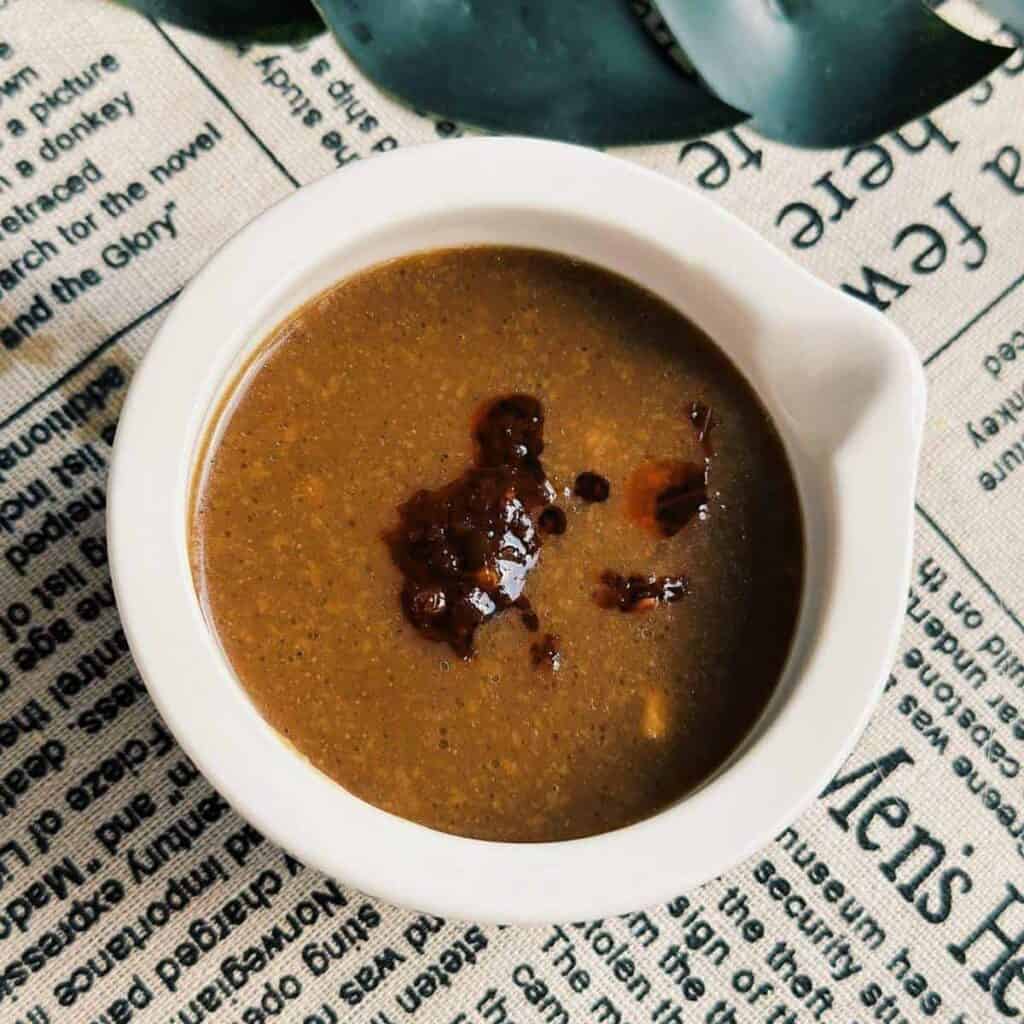Curious about that yellow spread in Bánh Mì next to the pate? That’s Vietnamese mayo — or “Vietnamese butter,” Sốt Bơ Trứng, even though it isn’t real butter.
Creamy, rich, and essential, it’s a signature in Saigon-style Bánh Mì.

What’s Inside
What is Vietnamese mayo?
When I was a kid, imported products were rare in Vietnam, and real mayonnaise wasn’t common like today.
The “mayo” I grew up with was that yellow sauce made simply from egg yolks and oil — our very own Vietnamese mayo.

Back then, making it took real effort because we didn’t have electric mixers, so even though I loved it, I didn’t get to enjoy it often.
These days, you’ll find this sauce everywhere — not just in Saigon-style Bánh Mì, but also in Vietnamese bakery favorites like Bánh Bông Lan Trứng Muối (Vietnamese sponge cake with salted egg) and pork floss buns.

Ingredients
Fresh Egg Yolks: I recommend pasteurized eggs. If using regular ones, you’ll need to pasteurize them with a bain-marie.
Neutral Cooking Oil: I’ve tried garlic and shallot oil, but neutral oil still works best — great flavor without the extra hassle.
Salt: Adds depth.
Vinegar (5%): Adds a touch of tang to balance the flavors.
Sugar: Brings sweetness. If you skip the honey or condensed milk, just add a bit more sugar.
Butter (optional): Adds extra richness.
Honey / Condensed Milk (optional): Optional but highly recommended for a rounder, creamier taste.
Instructions
Step 1 – Pasteurize eggs (skip if using pasteurized eggs):
- For regular eggs, set up a bain-marie: place a wide bowl over a saucepan with simmering water, making sure only steam touches the bowl. Lower heat to low once the water boils.
- In the bowl, combine egg yolks, sugar, salt, and vinegar. Place it over the saucepan. Whisk continuously until the mixture reaches 140°F (60°C), then whisk for 3 more minutes. Remove from heat.

Step 2- Make the mayo:
- Using a hand whisk or a hand mixer with a single whisk attachment at medium speed, slowly add oil, ½–1 tsp at a time, whisking thoroughly until each addition is fully emulsified. Adding too much oil too quickly can prevent thickening.
- Continue whisking and gradually adding oil. As the sauce thickens, you can add slightly more at a time. This takes about 10 minutes until all the oil is incorporated and the mayo is thick and fully emulsified.
- Gradually pour the hot melted butter into the egg yolks while whisking continuously. Add honey or condensed milk and whisk to combine.

Step 3 – Store:
- Transfer the mayo to an airtight container and refrigerate. It keeps for 3–5 days.
Deal with Separated Mayo

If your Vietnamese Mayo ends up separating and doesn’t thicken properly, don’t worry! Here’s a simple solution to salvage it:
- Prepare a fresh batch of mayo following the original recipe.
- As the new batch begins to thicken, slowly pour the separated mayo into the mixture.
- Whisk the combined mixture vigorously until it is well combined and thickened.
Expert Tips
Flavor twists: In Vietnam, there’s a playful version called green mayo, Sốt Bơ Cốm, made with cốm (young green rice) and sometimes a purple version with taro paste. For an easy twist, add a few drops of pandan or ube extract.
Adjust oil: The more oil you add, the thicker the mayo becomes, and the egg flavor will be milder.
No-raw egg option: Want to skip raw eggs? Try my no-raw egg Vietnamese mayo — all the flavor, zero worry.
Enjoy with Bánh Mì: For a full Banh Mi experience, add Vietnamese liver pate, a crisp Vietnamese baguette, Do Chua pickles, and Cha Lua (pork roll). For a quick fix, just mayo and pork floss is insanely addictive too!
Other tasty dishes with Vietnamese mayo: Banh Mi charcuterie board, Bo Ne (Vietnamese steak & eggs).
More Vietnamese cooking essentials

(Vietnamese Dipping Fish Sauce)

(Sốt Sa Tế)

(Vietnamese Caramel Sauce)

Vietnamese Honey Mayo (Butter / Bơ) for Banh Mi
Equipment
- 1 Sauce pan
- 1 Glass or Steel Mixing Bowl
- 1 Whisk or Handmixer
Ingredients
- 2 egg yolks
- ½ cup neutral cooking oil (125ml)
- ¼ tsp salt
- ½ tsp vinegar
- 2 tbsp sugar (or 3 tbsp if skipping honey/condensed milk)
- 1 tbsp honey / condensed milk
- 2 tbsp hot melted butter
Instructions
Pasteurize Eggs (skip if using pasteurized eggs)
- For regular eggs, set up a bain-marie: place a wide bowl over a saucepan of simmering water, making sure only steam touches the bowl. Lower heat once water boils.
- In the bowl, combine egg yolks, sugar, salt, and vinegar. Whisk continuously until the mixture reaches 140°F (60°C), then whisk 3 more minutes. Remove from heat.
Make the Mayo
- Using a hand whisk or mixer at medium speed, slowly add oil ½–1 tsp at a time, whisking until fully emulsified. Continue gradually for ~10 minutes until thick and smooth.
- Gradually whisk in hot melted butter. Add honey or condensed milk and mix until combined.
Store
- Transfer to an airtight container and refrigerate for 3–5 days.


Nice and clear instruction, thank you so much
Nice and clear instruction, thank you so much. Could you share how to make pickled carrot?
Hello, sorry for my late response. I have already written a recipe for Đồ Chua (pickled carrot & daikon) here:
Thanks for your great recipe
Thanks you for the great recipe. It’s delicious.
really authentic one
Ngon vl
Perfect for my Banh Mi!!
Love it thanks for sharing ♥️
Love it thanks for sharing!
This is what I’m looking for! Thanks for sharing my dear
I tried your recipe and it turned out quite nice (very identical to the one in Vietnamese market). Thank you for sharing.